
Watch: Some EV Charging Stations Are Burning up Batteries: Who Pays?
Yeah, we know, public charging sucks. Half the EV chargers don’t work, and there’s a line for quick charging. But once you get to that Electrify America charging station, there is a new hassle to worry about. And this costs much more than an extra 45 minutes of time wasted. Charging stations are roasting batteries. They pop and crackle, and then your $20,000 battery is junk.
That’s bad enough, but now the question is, “Who pays for a new replacement?” There is a pyrotechnic fuse that is supposed to shut off the charger if the temperature rises beyond a certain point. Sometimes, they work well, but other times, it is too late, and your battery is toast.
So, who is responsible for EV charging station problems?

If you don’t believe it, Twitter (X?) user truthVtold posted it happening to two different EVs in Burbank, California. So, let’s say this happens, and you’re 200 miles from your destination. Roadside assistance coverage is there to tow your car to the nearest EV repair shop. But you’ve still got to get back home to your destination or find the closest hotel.
Who pays for this? And should your battery be ashes and you need a replacement, who is responsible for that big hit? Batteries are beyond expensive.
What probably happens next is insurance companies representing both the manufacturer and Electrify America, where most of these incidents are allegedly occurring, will want to inspect the car. Then a determination will be forthcoming, maybe in two weeks. Or maybe two months.
What are the three ways an EV charging station problem happens?

So now you’re without wheels for an extended time. Who pays for that? Then, as CleanTechnica points out, “…what to do with older and/or high mileage, out-of-warranty EVs?” At some point, the overall value is less than the new battery cost. That, and whatever else got the fizzle.
But there are only three reasons this happens. Either the charging station pumped too many electrons into the EV, or the EV’s charging system didn’t shut down, or the EV is out of warranty, and nobody is really responsible, including the owner.
What can EV owners do?

But the owner is still out lots of cha-cha as the costs to take up whatever happens afterward continue to escalate. So, how should companies deal with these out-of-pocket expenses? Either car insurance, manufacturer coverage, or the insurance carrier for the charging station needs to come together to determine how these post-charging malfunctions get paid while a source for the malfunction is ongoing.
We’re not in the insurance game, nor are we lawyers. So, it is impossible for anyone but these decision-makers to resolve the issue. But should word spread that this pickle could be facing EV buyers, it would be another reason for EV buyers to be wary of pulling the trigger and making a purchase. And the fewer buyers there are, the slower the economy of scale profits flow into manufacturer and charging station coffers.



